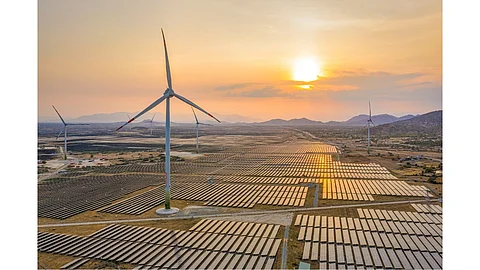

Wind- and solar-heavy grids, with shares of up to 80%, are technically possible, claims an ETC report
The rapid decline in solar and wind costs has made them competitive with fossil fuels worldwide, with the cost advantage expected to grow
‘Sun belt’ nations could lower electricity costs to as little as $30–$40/MWh by 2050
India could achieve its 2050 clean power target with 80% solar, 20% wind, and short-term storage solutions
Wind and solar-dominated energy systems, with power generation shares as high as 70% to 80%, are technically possible finds an Energy Transitions Commission (ETC) report. It says these renewable sources, when supported by advanced grid and balancing technologies, can be as stable and resilient as fossil fuel-based ones.
Such systems can supply round-the-clock (RTC) electricity at costs equal to or below today’s fossil fuel generation.
The report writers expect the lowest costs in low-latitude ‘sun belt’ countries, such as India, Mexico, and much of Africa, thanks to abundant solar resources and only short-duration balancing needs. Here, costs can more than halve to $30/MWh to $40/MWh by 2050.
India, for instance, could reduce its power costs to $50/MWh with a solar-wind based electricity system to achieve a clean power system by 2050, since this will provide it day-night balancing. As per ETC modeling, solar would account for close to 80% of India’s installed capacity, while wind will provide the remaining 20% share.
By 2050, the report writers expect this setup to help India generate around 7,300 TWh of electricity annually, exceeding the country’s projected demand of 5,500 TWh, and more than triple the 2024 consumption of roughly 1,600 TWh. India would need to time-shift 40% of the electricity supply using short-duration storage to match demand. This can be done with minimal need for seasonal or multi-week balancing.
High-latitude nations, or ‘wind belt’ countries, such as the UK, Germany, and Canada, which depend more on wind and require substantial seasonal balancing, will face higher costs unless they have significant hydro capacity for affordable balancing. Even so, their costs should remain at or slightly below current levels.
Solar PV deployments have soared over the last few years, led by market leader China. In fact, the rapid growth of solar and wind has been driven by faster-than-expected cost reductions, as per ETC report titled Power Systems Transformation: Delivering Competitive, Resilient Electricity in High-Renewable Systems.
Since 2010, the levelized cost of electricity (LCOE) for solar and wind has fallen by 92% and 70%, respectively, driven mainly by steep capital cost declines – 82% for fixed-axis PV, 68% for onshore wind, and 59% for offshore wind. In China, solar and wind CapEx fell by 83% and 79% between 2014 and 2024.
These reductions, alongside lower installation and other costs, have made unsubsidized solar and wind competitive with fossil fuels in many markets. Projections indicate this cost advantage will widen, with solar expected to become the cheapest source of non-firm electricity in nearly all countries vis-à-vis traditional fossil fuel generation.
According to the ETC report, reaching the ‘last mile’ of decarbonization will be the most expensive stage, especially in countries that need ultra-long duration energy storage to manage seasonal supply and demand shifts, such as high-latitude, wind-dependent countries. “Once countries have reached very low levels of carbon intensity (e.g., less than 50g per kWh), electrification is more important than rapid last-mile decarbonization,” reads the report.
Achieving this power system transformation requires smart planning and innovation to deliver affordable, reliable electricity worldwide.
Recommendations
Among the 6 main enabling measures the ETC report suggests are policies that reduce investor risk and support efficient capital allocation by incentivizing deployment of grid and flexibility technologies.
The governments will also need to address potential supply chain and workforce bottlenecks and strengthen resilience.
Up to 30% of global electricity demand could be shifted in time through demand-side flexibility, supported by dynamic pricing and smart energy management.
While grid costs per kWh can remain stable, total global grid length will need to more than double to 150–200 million km by 2050 to support growing volumes of wind and solar energy capacity, with annual investment rising from $370 billion in 2024 to a peak of $870 billion in the 2030s. However, around 35% of expansion costs could be avoided by deploying innovative grid technologies.
Achieving low-cost, high-renewable power systems will require coordinated planning, market reforms for fair competition, modernized grids, stronger supply chains, and active customer participation.
